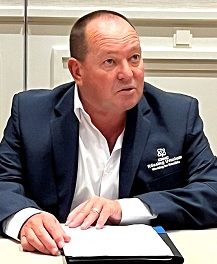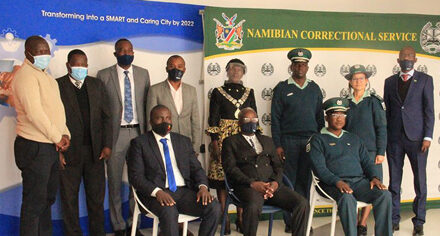
Five-years of ensuring Windhoek’s drinking water through managed aquifer recharging

The practice of managed aquifer recharge by the City of Windhoek ensured that the supply of potable water to Windhoek residents remained uninterrupted over the past five years.
The City currently has seven established recharge stations where water can be injected into the underground aquifer to enhance the groundwater replenishment process in Windhoek, which is otherwise slow under Namibia’s arid conditions.
This message was shared by City Councillor Austin Kwenani on Friday, 1 April at the commemoration of World Water Day, World Wetland Day, and International Day of Forests at the Safari Hotel and Conference Centre, which formed part of National Water Week. The national theme of the event is “Groundwater too precious for people, forests and wetlands – making the invisible, visible.”
Addressing the audience, Councillor Kwenani – who is also the chairperson of the council’s Economic Development, Public safety, and Citizen Welfare Committee – said, “The previous drought period leading up to early 2020 showcased the effectiveness of the management of Windhoek’s aquifer and other, surrounding aquifers. The abstraction of groundwater shifted from a supplemental role to the main conjunctive supply source. Much of the industry’s water requirements were met via abstraction from boreholes, again proving the importance of groundwater to our city’s vibrancy and long-term sustainability. The MAR method significantly contributes to the recovery of groundwater levels after periods of drought and high dependencies on the aquifer system to provide potable water.”
The MAR process is considered the most cost-effective way to, with the government’s support, develop the necessary infrastructure to safeguard Windhoek’s water supply during prolonged periods of drought. The concept of artificial recharging the aquifer dates back to the 1990s when Council explored various water supply options to augment Windhoek’s future water requirements.
The recharging method involves banking excess water during times of sufficient surface water supply. This then presents an opportunity to abstract the banked water at a later stage, during dry seasons.
Groundwater also plays a vital role in the preservation of Windhoek’s forests. It is the only source of water for Windhoek’s indigenous Camelthorn forest in the so-called Camelthorn Belt, northeast of the capital.
Councillor Kwenani added that: “The interplay between groundwater and the associated biological resources like forests and wetlands requires greater emphasis. These biological resources are known to significantly contribute toward meeting the water quality objectives of intended water users. Windhoek has no perennial rivers and no naturally occurring wetlands therefore groundwater remains the only source of water along with the riverine ecosystem. Today’s event affords us an opportunity to reflect on our past, current, and future efforts which must prioritise the protection of our ground and surface water. As such, it is our pledge to place special emphasis on how our forests and other plant communities associated with wetlands can thrive and contribute to meeting the water quality objectives of Windhoek communities and promote meaningful, long-term socio-economic benefits.”
The majority of Namibia’s geographic landscape is semi-arid with Windhoek’s average rainfall per year around 370mm. Meanwhile, Namibia’s yearly evaporation ranges from 2 600mm in the northeast to 3 700mm in the central and southern areas. These extreme conditions compel us to be more proactive and innovative around water augmentation methods like, in the case of Windhoek, through wastewater reclamation plants and more recently, via the aquifer recharge project.
World Wetland Day and World Water Day are two days celebrated internationally each year to raise awareness about wetlands and water resources, to draw attention to the value of each as a precious life-giving and finite resource, to promote sustainable development and utilisation of these valuable assets. Wetlands include rivers, pans, lakes, Oshana’s, floodplains, dams and shallow sea waters.
Wetlands provide crucial services to human beings and the environment such as carbon absorption, flood attenuation, groundwater recharge, and water purification. In addition, wetlands provide much-needed goods to our communities like water, food, reeds, wood, maintain soil fertility, and grass for domestic and wild animals. Namibia acceded to the Ramsar Convention in 1995 and to date the country boasts five wetlands of international importance namely the Orange River Mouth, Sandwich Harbour, Walvis Bay Lagoon, Etosha Pan, and Okavango-Bwabwata.











































